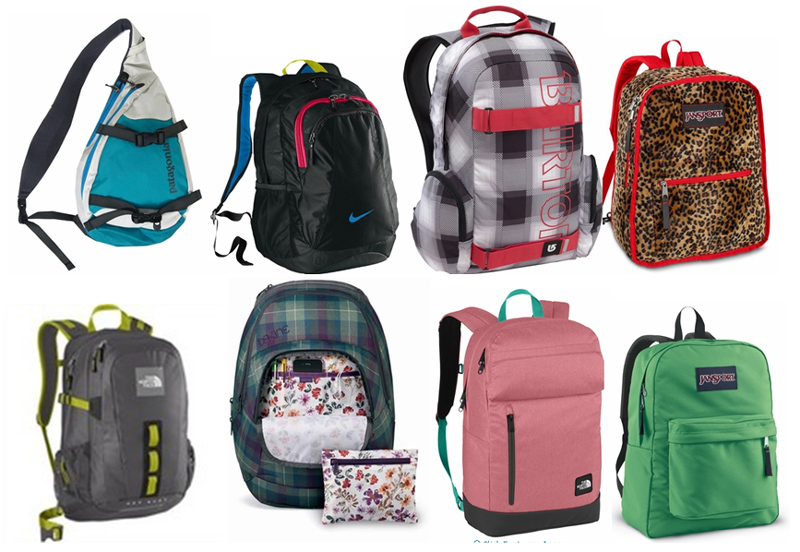- How do I find the right backpack for me?
- What are the typical parts of backpacks?
- How do I find the right backpack to fit my body type?
- How much room do I need in my bookbag?
- What materials are backpacks made from?
- How do I know which materials are used in my backpack, and what they offer me?
- How does my personal preference, style, and aesthetics affect my backpack decision?
How do I find the right backpack for me?
We offer a huge selection of backpacks and bookbags for almost every need, style, and budget out there. Although we strive to bring you the widest variety and most options possible, navigating through them to find the right one for you can be overwhelming. So to narrow things down, it helps to consider the following when buying a backpack:
- Your body type - Great backpacks should fit your body and build. This helps to prevent back strain and muscle fatigue.
- The type of activity you need the backpack for, and the things you'll be carrying - The types of backpacks you look at, and eventually choose, should depend on what you plan carrying. If you need your laptop with you for work or school, you'll need a bookbag with a laptop sleeve. These backpacks have vastly different features than a backpack for the person going on weekend hiking trips, and needs to carry an ice-pick, walking stick, and extra winter jacket.
- How often you will be using the backpack - Those using a backpack daily will need one made of a stronger, more durable material. If you're the type that only wears backpacks every few months for short day trips, durability and strength shouldn't be as high of a concern.
- Your personal preferences - Backpacks come in a huge variety of different styles, prints, colors, and designs. Once you have an idea of what type of bookbag will fit you, and what features you need, the only thing left to decide on is the look!
What are the typical parts of backpacks?
Before we can go on to help you find the right size, type, and color backpack for you, it's important to understand the parts of backpacks, and what each part does for you. This will help you determine which features you need, and which you could do without:
Back Panel
- Purpose:
- The back panel gives the bookbag its structure. It's also the largest part of the pack that rests on the user. Comfort is an important factor in finding the right back panel, especially if the backpack is worn for long periods of time. Backpacks with padded or vented foam back panels can reduce fatigue and heat, keeping your back comfortable and dry.
- Types:
- Padded - Most backpacks have a foam-padded back panel to improve comfort and cushion your back, while also creating a protective barrier between your back and the stuff inside the pack.
- Padded with Recessed Channel - Designed to take pressure away from your spine, the recessed channel gives you a more comfortable fit especially while carrying heavy loads.
- Moisture Management - Some brands, such as The North Face backpacks, strategically structure their backpacks to minimize back sweat, using a combination of mesh ventilation and stitched recess channels.
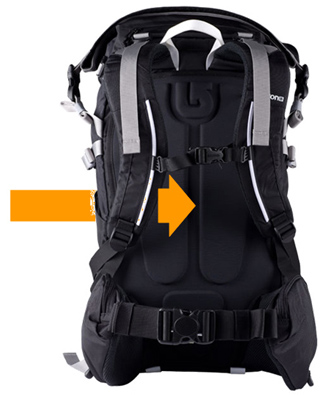
Shoulder Straps
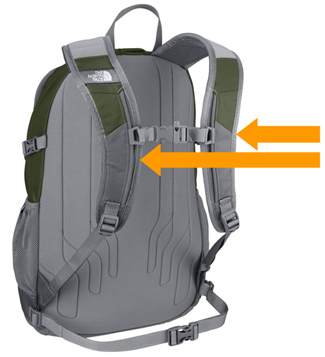
- Purpose:
- To rest the backpack over your shoulders. Most of the bookbag's weight rests on your shoulders, if you don't use a hip belt or sternum strap. Personal comfort is the most important factor in choosing shoulder straps!
- Padded - Most backpacks have at least a little padding in the shoulder straps to improve comfort.
- Injection Molded - Some bookbags strategically cushion their shoulder straps to deliver flexibility where it's needed, and protective cushioning in necessary areas, moving strain away from your collar bone and other pressure points.
Waist / Hip Belt
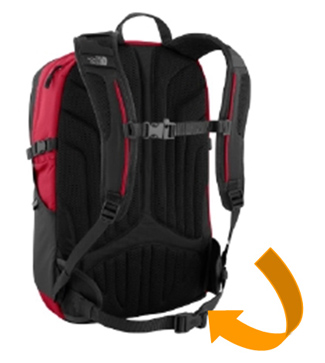
- Purpose:
- Various organizational pockets throughout the backpack hold and organize smaller items, preventing them from getting lost or forgotten in the bottom of the bag.
- Padded - Most backpacks have at least a little padding in the shoulder straps to improve comfort.
- Injection Molded - Some bookbags strategically cushion their shoulder straps to deliver flexibility where it's needed, and protective cushioning in necessary areas, moving strain away from your collar bone and other pressure points.
Sternum Straps
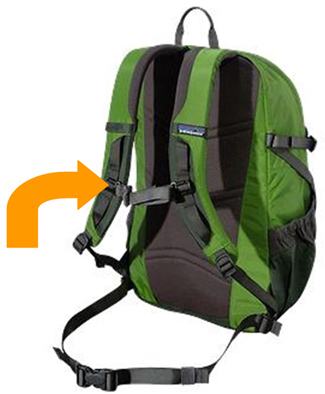
- Purpose:
- To pull the shoulder straps closer together, keeping them in place, and taking strain off of your back and shoulders.
Organization
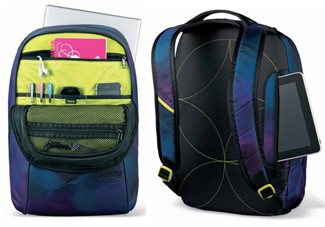
- Purpose:
- The back panel gives the bookbag its structure. It's also the largest part of the pack that rests on the user. Comfort is an important factor in finding the right back panel, especially if the backpack is worn for long periods of time. Backpacks with padded or vented foam back panels can reduce fatigue and heat, keeping your back comfortable and dry.
- Organizational Pocket - Most backpacks feature one or more compartments with organization pockets. These typically feature slots and areas to hold pens, iPods, cell phones, etc.
- Laptop Sleeve - Some backpacks feature a padded sleeve specifically designed to hold and protect a laptop computer.
- Hydration Compatible - A pocketed area designed to hold a hydration reservoir in place, with a hydration tube port, makes staying hydrated easy during long hikes and walks.
Other Common Backpack Features:
- Water Bottle Pockets - Holds water bottles for quick hydration on hikes or long walks
- Safety Whistle - A safety whistle attached to the sternum strap of backpacks in The North Face backpacks collection, helps to let people know where you are
- Electronics Pocket and Media Port - Some bookbags include pockets to hold a phone or MP3 player, with a port for headphones to come out of
- Board Carry - Skate and snowboard backpacks include two horizontal straps on the outside of the pack to hold your board
- Shovel Storage Pocket - Brands like Burton Backpacks include a storage pocket for a small shovel in some backpacks, meant for building jumps or digging yourself out of trouble
- Goggle / Sunglasses Pocket - Some brands include a fleece or plush lined pocket in their backpacks, designed to fit snow goggles or sunglasses, protecting them from scratches
- Laptop Cord Pocket - Some bookbags include a separate pocket to keep your laptop cord from tangling
- iPad Compatible - Recently, new backpacks are making padded pockets to accommodate an iPad or similar tablet device
- Reflective Details - Designed to increase nighttime or low-light visibility, these details keep you safe while walking or riding at night
- Webbing Utility Loops - Located on the exterior of the bag, these loops hold objects like trekking poles, ice axes, and other items you wouldn't want to keep inside the backpack, and you would need quick access to
- Drop / Stash Pockets - Exterior pockets on the front of backpacks allow easy access and quick storage of essential items
- Exterior Bungee Cords - These cords give added structure to the bag and can also be used to hold bulky items outside of the bag
- Rain Cover - Some hiking backpacks include a rain cover to pull over the bag to keep it and its contents dry
- Shoe / Laundry / Wet Pocket - These pockets are often lined with waterproof fabrics, and work to keep wet, dirty, or smelly clothes or shoes separate from the main compartment
- Insulated Cooler Compartment - These pockets keep your lunch or a beverage cool. Typically lined with waterproof fabrics, it can also act as a wet pocket
How do I find the right backpack to fit my body type?
Having a backpack that fits your body type is incredibly important to both your continued comfort and physical health while carrying the pack. Most backpacks and brands appeal to a wide variety of body types. Some brands make specific women's backpacks, with curved, narrower shoulder straps, smaller profiles, shorter torsos, and wider hip belts to better fit a woman's figure.
Before using your backpack, it's important to adjust it to properly fit you. Put some weight in the pack to replicate its actual fit while in use, and adjust the:
- Hip Belt - These should fit snuggly around you waist when clipped together
- Shoulder Straps - These should be tightened enough so that the point where the straps meet the pack is just below the large bone at the base of your neck, at the top where your shoulders meet. The bottom of your pack should be pulled up to just above your hips, and should not droop past this point
- Sternum Straps - Fasten these to keep the shoulder straps in place. These should not restrict your breathing
How much room do I need in my bookbag?
This should completely depend on what you need to carry and how you're using the bookbag. If you need a backpack for elementary school, then look for smaller, more durable backpacks. However, if you're a regular hiker and camper, a large-capacity hiking backpack is best for you.
What materials are backpacks made from?
Most modern backpacks are made from different combinations of polyesters and nylons with varying deniers (D). Denier is a measurement of fiber firmness, and is typically measured in weight (grams). Denier is measured by the mass in grams per 9000 meters, so: 9000 meters of a 600D thread = 600 grams
A backpack's fiber combination and denier thickness can affect its weight, durability, water and abrasion resistance, feel, color fastness, and most importantly, price! Check out the following charts to better understand the differences between the fabrics used in backpacks, and how denier thickness truly affects the make-up of the bag:
| Polyester | Nylon | |
| Less durable | More durable than polyester | |
| Retains color | Color fades over time | |
| A fiber-like, textured feel | A silky, smooth feel | |
| Water repellant | Water absorbent | |
| Lower resistance to odor and bacteria | Higher resistance to odor and bacteria | |
| Low abrasion resistance | High abrasion resistance | |
As Denier increases, so does a backpack's:

- Weight: It will have a heavier feel
- Durability and Strength: The pack will last longer and the backpack can hold heavier loads without tearing or losing its shape
- Water Resistance: The product becomes more water resistant
- Abrasion Resistance AKA Tenacity: Because of its heavy weight, the bookbag will become more resistant to tearing
- Solidity: The backpack becomes less sheer, will feel less soft to the touch, and will become sturdier and harder
- Price: The price of the backpack will increase as denier increases
*Since nylon is more durable than polyester, the overall durability of a backpack can often be confused. Typically, durability increases as the denier count does, but the use of nylon should be taken into consideration. For instance, a 420D nylon bag will be stronger than a 600D polyester bag.
How do I know which materials are used in my backpack, and what they offer me?
Different backpacks, bookbags, and brands use all sorts of materials, outside of traditional polyester and nylon. Assess the following glossary to understand which materials are used in your favorite bookbags, and what they offer:
| Term | Definition | |
| Ballistics Nylon | Ballistics nylon is made from a ballistic weave (a 2x2 fiber basket weave) of a varying denier. As the denier increases, the weave becomes stronger. Ballistics nylon is abrasion and tear resistant, as well as super durable. Because ballistic nylon is difficult to dye, it is often found in black or dark colored bookbags. | |
| Cordura | A brand name synthetic fabric made of nylon, known for its durability and resistance to tears and abrasions. | |
| Denier (D) | A measurement of the fineness of a fiber, and is usually measured in weight (grams). Denier is the mass in grams per 9000 meters. As the denier of backpacks increases, so do their weight, strength, durability, water resistance, abrasion and tear resistance, solidity, and price. | |
| Nylon | A commonly used synthetic fabric in bookbags, known for its durability, and resistance to abrasion and ripping. | |
| Nylon Ripstop | A woven nylon fabric, with a gridded reinforced technique. This reinforcement makes the fabric resistant to tearing. Bookbags with ripstop fabric can be identified by their gridded texture. | |
| PU Coating (Polyurethane) | Some backpacks have a PU coating, to increase water resistance of the fabric. | |
| Phathalate-Free TPE Laminate | Toxic Phthalates are not used in the production of the TPE laminate, which is a highly tear resistant synthetic fabric. | |
| Polyester | A versatile synthetic fabric that can be made from naturally occurring chemicals, as well as other synthetic materials, such as recycled water bottles. Natural polyesters can be biodegradable, while synthetic polyesters are not. Polyester bookbags, although not as durable and strong as nylon ones, have good durability, are water repellant, retain colors well, and have a resistance to bacteria. | |
| Polyester Dobby | A textured weave of polyester, creating a fabric with a textured look and feel. | |
| Polyester Twill | A diagonally patterned weave of polyester. Denim is also a twill fabric - so if you are wearing jeans, take a look! | |
How does my personal preference, style, and aesthetics affect my backpack decision?
Backpacks come in all sorts of shapes, styles, prints, and colors! We even offer a few that are reversible, so you get two looks to choose the one that best suits your mood. Once you know which type of backpack you're looking for, have fun choosing which style fits your personality!
